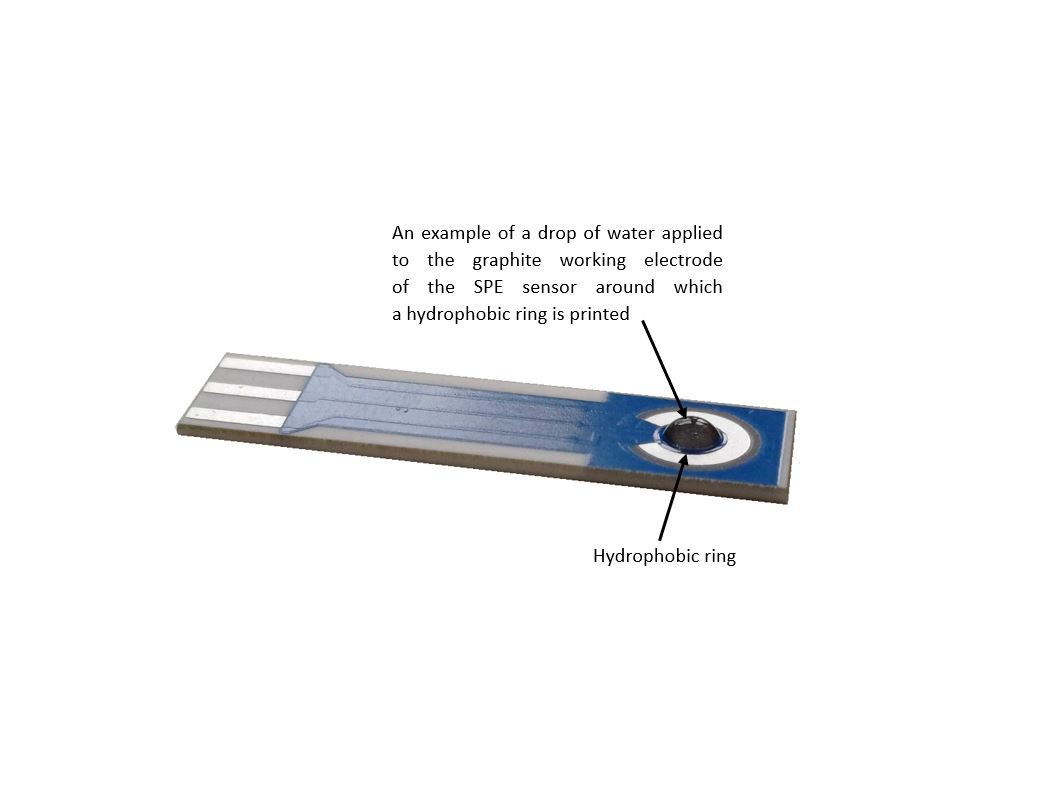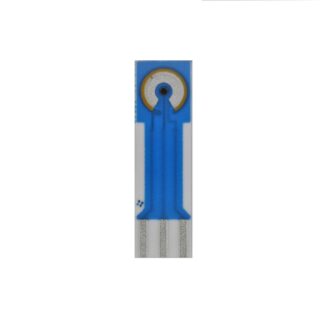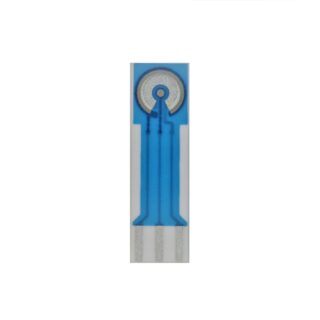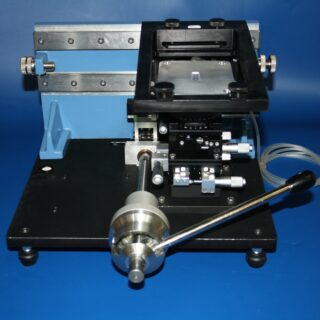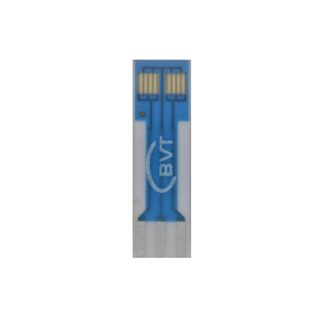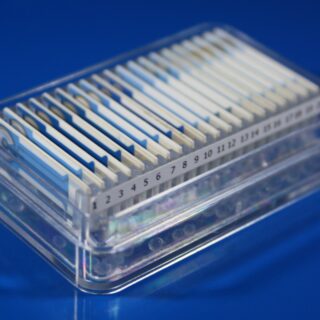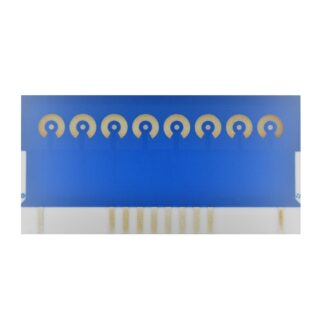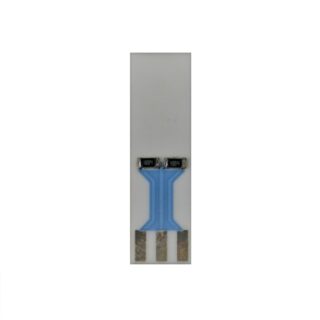Category
- Custom made glass products
- CUSTOMER SERVICES
- NEW PRODUCTS
- Sensors and electrodes
- Custom made and Modified Screen Printed Electrodes
- Stirrers
- Cables and connectors
- Cell
- Potentiostats
- Manual Screen Printer
- Minithermostat
- Pumps
- Accessories
- Kits & Sets
- Discounted SPEs (at a reduced price with visual defects/inconsistancies, but fully functional)
AC1. electrochemical sensor with a hydrophobic ring
Electrochemical sensor type AC1. with a hydrophobic ring – a hydrophobic layer is printed around the working electrode of the sensor (with a diameter of 1 or 2 mm), which ensures that the liquid applied to the working electrode of the sensor forms a drop and does not move outside to the reference and auxiliary electrodes (see the photograph below).
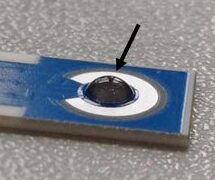
Such modification of the sensor is suitable, for example, before the next intended modification of only the working electrode of the sensor by the customer – for example, immobilization of a bioactive substance.
You may also like…
-
AC1P Electrochemical sensor
Read moreAmperometric three-electrode sensor with patented structure type AC1 with polished working electrode made by thick film technology.
Dimensions: 25.4 x 7.26 x 0.63 mm
WE material: Au
The sensor is formed on a corundum ceramic base. On to this surface the working, the reference and the auxiliary electrodes are applied. Working electrode has homogenous surface with roughness less than 1 µm. The working and the auxiliary electrodes are made of variety of materials. At the end of the sensor there is a contacting field which is connected with the active part by the silver conducting paths which are covered by a dielectric protection layer. A bio-chemically active substance can be immobilised on the working electrode of the sensor to create a biosensor.
-
AC1.AChE Electrochemical sensor
Read moreAmperometric Acetylcholinesterase three-electrode sensor with patented structure made by thick film technology
Dimensions: 25.4 x 7.26 x 0.63 mm
WE material: Pt
Sensor Usage: Measurement of AChE inhibitor concentration – especially organophosphorous and carbamate pesticides (paraoxon, malaoxon), toxic and neurotoxic gases (sarin, soman, tabun, VX).
Acetylcholinesterase from electric eel type VI-S is immobilized on the active surface of a working electrode of electrochemical sensor AC1.W2.RS (i.e. Platinum working electrode, silver reference electrode). The diameter of the immobilized bioactive membrane is 2 mm and the mean applied activity is 1 unit/mm2.
* For this product, we recommend our customers use the Training Service from BVT.
(https://bvt.cz/produkt/offer-of-long-term-automated-measurements-on-bvt-apparatus/)
-
MSP Manual Screen Printer
Read moreThe manual screen printer is useful for applying of biochemical paste on electrochemical sensors. It may be used for preparing customer design electrochemical sensors also.
It uses extremely small quantities of printing material. With the adjustment of the distance between the screen and the substrate the thickness of the printed elements can be varied. Under optimal conditions printing of lines with 200 µm can be achieved.
* For this product, we recommend our customers use the Training Service from BVT.
(https://bvt.cz/produkt/offer-of-long-term-automated-measurements-on-bvt-apparatus/)
-
AC1.GOD Electrochemical sensor
Read moreAmperometric Glucose Oxidase three-electrode sensor with patented structure made by thick film technology
Dimensions: 25.4 x 7.26 x 0.63 mm
WE material: Pt
Sensor Usage: Amperometric measurement of β-D-Glucose concentration in liquid samples (from 0 °C to 45 °C)
Glucose Oxidase (GOD) from Aspergillus Niger is immobilized on the active surface of a working electrode of amperometric substrate AC1.W2.RS.
The diameter of the immobilized bioactive membrane is 2 mm and the mean applied activity is 1 unit/mm2.
* For this product, we recommend our customers use the Training Service from BVT.
(https://bvt.cz/produkt/offer-of-long-term-automated-measurements-on-bvt-apparatus/)
Related products
-
CC2 Electrochemical sensor
Read moreA conductivity sensor with two active parts made by thick film technology with interdigitated structure of electrodes
Dimensions: 25.4 x 7.26 x 0.63 mm
WE material: Au/Pt, Au, Pt, Ag, C
The sensor is formed on a corundum ceramic base. Onto this surface two interdigitated structures of electrodes are applied. The electrodes are made of Platinum-Gold alloy in standard product CC2.WS. At the end of the sensor there is a contact which is connected with the active part by the silver conducting path which is covered by a dielectric protection layer. A bio-chemically active substance can be put on the electrodes, one interdigitated structure, the second structure is reference.
-
STK-C Customer Starting kit
Read moreStarting Kit STK.S-C
The customer starter kit is a set of twenty different electrochemical sensors to find the best one that suits your application.
The starter set contains at least 5 pcs of sensors type AC1.W*.R* from the given type of sensors with a working electrode diameter (Dw) 1 or 2 mm stored in a box with numbered positions and silica gel.
The exact choice of the given types of sensors in the kit is at the request of the customer.
-
AC5 Electrochemical sensor
Read moreScreen printed electrochemical array of 8 working electrodes
Dimensions: 25.4 x 50.8 x 0.63 mm
WE material: Au/Pt, Au, Pt, Ag, C
The sensor is formed on a corundum ceramic base. On to this surface the working and the reference electrodes are applied. The working electrodes create an array of eight electrodes. The electrodes can be made of variety of materials (see below). At the end of the sensor there is a contacting field which is connected with the active part by the silver conducting paths which are covered by a dielectric protection layer. A bio-chemically active substance can be immobilised on the working electrodes of the sensor.
-
TS Testing Sensor
Read moreSimple identifier of electrochemical hardware error
Dimensions: 25.4 x 7.26 x 0.63 mm
Electrochemical measurements are very sensitive. Sometimes cables, connectors and their wetness can create the measurement errors. Testing sensor enables simple identification of electrochemical hardware error. The sensor has same geometry as AC1 type but its response produced by resistor. The response is stable and independent on chemistry. Testing sensor is formed on a corundum ceramic base. At the end of the sensor there is a contacting field which is connected with the SMD resistors by the silver conducting paths which are covered by a dielectric protection layer.

